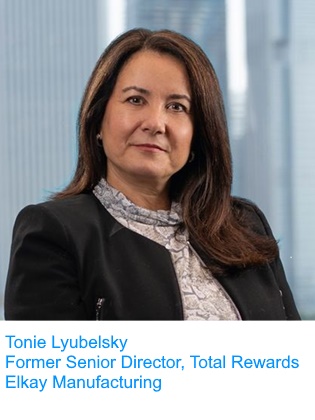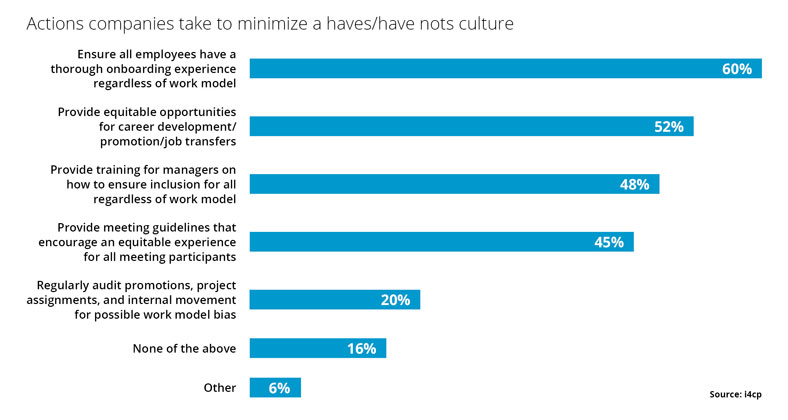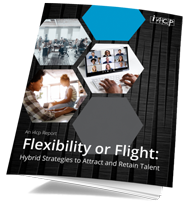Is Flexible Work Fair?

“You can’t make Oreos at home; people have to go to work in manufacturing facilities.”
This observation by Brooke Finlayson, chief learning officer of Mondelez International—the multinational food and beverage firm that makes the iconic cookies and has subsidiaries including many globally popular brands such as Nabisco, Cadbury, and others—succinctly speaks to a critical challenge many organizations encounter in defining what flexibility means for their workforces: There are countless jobs that can only be accomplished on-site in company facilities.
 Business leaders who responded to the Institute for Corporate Productivity’s (i4cp) latest survey on hybrid work reported that 79% of their organizations’ employees worked onsite in company facilities prior to the onset of the COVID-19 pandemic. When i4cp gathered data in late 2021, the figure for onsite workers was 33%, a still-significant proportion of the employee population (and one that varies across organizations and industries).
Business leaders who responded to the Institute for Corporate Productivity’s (i4cp) latest survey on hybrid work reported that 79% of their organizations’ employees worked onsite in company facilities prior to the onset of the COVID-19 pandemic. When i4cp gathered data in late 2021, the figure for onsite workers was 33%, a still-significant proportion of the employee population (and one that varies across organizations and industries).
Threats to the health of the workforce brought on by the pandemic sent employees whose jobs were not location-specific to work remotely in 2020. Having grown used to the increased flexibility that remote work afforded, many of those workers now clamor for continued flexibility even as some employers aim to return people to company workplaces (as COVID surges and variants permit). The individuals who must work on-site in company facilities naturally want greater flexibility too—and the enhanced employee experience it offers.
But can organizations deliver equitable flexibility, and, by extension, an equitable employee experience across varying work settings? With thoughtful planning and innovative actions, flexibility and enhanced employee experiences can be possible for both remote and on-site workers. In fact, some organizations are already leading the way.
Flexibility itself must be flexible
i4cp’s From Cube to Cloud: The Next Era of Work study looked at three elements companies use to define flexible work, singly or in combination. Data gathered found large companies primarily thinking of flexibility in terms of work location:
 The findings from the aforementioned study on future scenarios for work make it obvious that some companies may risk limiting themselves by focusing too heavily on only one aspect of workplace flexibility. But other organizations are increasingly thinking beyond work locations when they imagine what flexibility means for their employees. In fact, those firms are putting time and resources into thoughtfully exploring what flexibility should look like in order to best fit their enterprises.
The findings from the aforementioned study on future scenarios for work make it obvious that some companies may risk limiting themselves by focusing too heavily on only one aspect of workplace flexibility. But other organizations are increasingly thinking beyond work locations when they imagine what flexibility means for their employees. In fact, those firms are putting time and resources into thoughtfully exploring what flexibility should look like in order to best fit their enterprises.
Mondelez redefines flexibility for a global workforce
Like many global employers, Mondelez International has reconsidered its view of flexibility since the onset of the pandemic. Says former global people lead Mary O’Malley, “We’ve broadened our definition of flexibility to support work-life balance, and that may look different across our locations around the world, depending on what local markets and our colleagues need.”
O’Malley says that soon after COVID-19 sent many employees home, the decision was made that Mondelez would embrace flexible work on an ongoing basis. To explore and formalize what that flexibility would mean for the company and its employees, Mondelez assembled a global team representing legal, corporate affairs, headquarters services, facilities, and other functions.
“The team looked at every country in which we operate and how flexibility could work, given local laws, cultures, living conditions, and other considerations,” O’Malley explains. “We had representation that linked back to our different regions and business units. We have a global policy, but even if you say everyone can work from home, there may be local requirements to satisfy—legislation, works councils, unions, and the like.”
There were also the company’s physical footprints to consider—why and when employees might need to work onsite and whether workplaces required downsizing or redesigns to accommodate safety and effective collaboration.
Listening closely to employee sentiment was an important component of redefining flexibility at Mondelez. An employee survey provided visibility into workers’ needs, helping to further shape policies and practices. Finlayson adds that sessions were held with line managers too, providing guidance on “how to have clear and transparent conversations with their employees about working flexibly—what that might look like, and what it means for them.”
Getting leadership buy-in and support was accomplished by tracking and reporting the improvements in business results and employee engagement that occurred following the expansion of flexible work at Mondelez. Further, O’Malley and her global team created a toolkit of (still-evolving) resources to help leaders think through new ways of working and to encourage them to become role models for the flexible approach.
“The world has changed, and expectations of employees have changed,” O’Malley says. “This ongoing flexibility will help with engagement, retaining talent, and with acquiring talent. Employees are embracing it, and working flexibly is helping them reduce stress and balance their work and life commitments.”
Some companies apply intentional actions to level the on-site/remote playing field
The potential for inequities in work flexibility is an issue on the minds of the global team at Mondelez as in many other organizations that employ individuals whose job duties can only be performed on-site in company facilities. Care must be taken to avoid the unintentional creation of a sort of two-class system polarizing employees who can work remotely and those who can’t.
Yet, when i4cp’s hybrid work survey asked about the types of flexibility organizations offer workers whose jobs require them to be on-site, the largest proportion of participating business leaders (one in four) said that their firms offered no flexibility for that group of employees.
Absent the option of location flexibility for on-site staff, some companies provide consideration in scheduling and/or hours worked, but the percentages of organizations taking action to make greater flexibility available to the on-site employee population is lacking (evidenced by low percentages of adoption revealed by the research).
Elkay Manufacturing is leading the way in thinking creatively about flexibility for on-site employees and modeling the application of accommodations in scheduling and work time.
Elkay incorporates measures to maximize flexibility for on-site workers
Elkay Manufacturing has produced sinks, faucets, and other residential and commercial products for more than 100 years. To ensure a steady output and the ongoing innovation that drives new-product development, the company employs a significant population of workers whose jobs require their presence on-site in Elkay facilities.
 Having recognized the possibility that those on-site workers might perceive inequities in flexibility and employee experiences (versus the large portion of Elkay’s workforce that is able to work virtually or combine remote and on-site duties), talent leaders have spearheaded innovative strategies to ensure that on-site workers feel valued.
Having recognized the possibility that those on-site workers might perceive inequities in flexibility and employee experiences (versus the large portion of Elkay’s workforce that is able to work virtually or combine remote and on-site duties), talent leaders have spearheaded innovative strategies to ensure that on-site workers feel valued.
“We talk about this all the time,” says Tonie Lyubelsky, former senior director of total rewards at Elkay. “We’re very mindful of trying to be equitable where we can in anything we do, but especially as it relates to our manufacturing employees who must work on-site.” And the company adopted that perspective early on, Lyubelsky says. “For those people who had to remain on-site from the beginning of the COVID-19 outbreak, we tried to offer flexibility wherever we can. And we continue to do that.”
One key to Elkay’s efforts to be fair involves looking at flexibility through the lens of jobs, not people. Says Lyubelsky: “In discussing work arrangements, we always say that it depends on the job, so it’s never about office people versus those in manufacturing, or exempt versus non-exempt. As a result, for our employees, flexibility has always been about talking to your manager, understanding what your job is, and how you interact with others.”
The company continues to evolve that job-based perspective and actively enlists managers to confer with their team members to determine what sorts of flexibility can be arranged to accommodate both individual and company needs. Those conversations—for which managers received training and supportive resources—explore remote and hybrid work options for employees whose jobs don’t require their presence in Elkay workplaces.
Managers also help to design flexible options for manufacturing workers and others who must be on-site daily. Lyubelsky says this often manifests as schedule flexibility. “Perhaps a manufacturing or other on-site employee needs to step away to pick up a child from school and then come back to work, or move start and end times to accommodate special needs. Employees can collaborate with their managers to arrange that kind of flexibility.”
She notes that Elkay takes other actions to ensure that on-site workers feel valued and don’t view the company culture as a haves-versus-have-nots dichotomy. “We do things like weekly pizza luncheons, and hold more social gatherings for manufacturing employees so that they feel connected and know that they are special. We also did appreciation pay for those on-site workers who were essential during the pandemic.”
Further, Elkay is considering enhanced support to help on-site employees better manage childcare needs. “While flexible schedules help, childcare can add pressure, so we are looking at other types of support to help our manufacturing employees with those challenges.”
 Finally, Lyubelsky shares an innovative approach Elkay applies in its efforts to ensure equity for tenured employees as the company applies new strategies to compete for sought-after manufacturing workers in a tightening talent market. “Whatever we do to attract new employees, we also do for our current workers. If we were to give new-hire bonuses, for example, we’d also look at giving bonuses to current employees because they are equally important to us. That’s another way in which Elkay is helping to make flexibility equitable for people who must work on-site.”
Finally, Lyubelsky shares an innovative approach Elkay applies in its efforts to ensure equity for tenured employees as the company applies new strategies to compete for sought-after manufacturing workers in a tightening talent market. “Whatever we do to attract new employees, we also do for our current workers. If we were to give new-hire bonuses, for example, we’d also look at giving bonuses to current employees because they are equally important to us. That’s another way in which Elkay is helping to make flexibility equitable for people who must work on-site.”
Flexible work continues to evolve
Organizations must apply creativity to find their own sweet spots when it comes to flexibility and equity in its application across employee groups.
The i4cp research into hybrid work identified some of the strategies organizations are using to help address employee experience and mitigate the perception of a dual culture of haves and have-nots. For the largest proportion of survey respondents (60%), efforts begin early with thorough onboarding for all employees, regardless of work model. Just over half of survey participants cite equitable opportunities for career advancement as their second-ranked strategy.
 The study on hybrid work practices concluded that offering the greatest possible degree of flexibility is the optimal route for organizations seeking to maximize performance, workforce engagement, and equitable employee experiences across all work settings within a hybrid model.
The study on hybrid work practices concluded that offering the greatest possible degree of flexibility is the optimal route for organizations seeking to maximize performance, workforce engagement, and equitable employee experiences across all work settings within a hybrid model.
Further, the data revealed an approach that proves to be a distinguishing practice of high-performance organizations and one that any company aiming for greater success in designing flexible work can apply: The act of involving employees in decisions about flexible work options reflects strong correlations to better organizational market performance and is linked to corporate cultures that drive better employee experiences.
Like Elkay Manufacturing and Mondelez, most organizations surveyed by i4cp look to employees and their managers to work together to make flexible work decisions, though some place that responsibility in the hands of employees alone. Employee input about work flexibility can be gained by other methods, too—Mondelez’s employee surveys are an example of an often-used tool to solicit workers’ opinions.
As approaches to hybrid work continue to evolve, leading organizations will find more ways to offer options to both on-site and remote employees while also attending to the need for equitable experiences for all. In short, savvy business and talent leaders will do what they can to ensure that flexible work is as fair as it can be.
 For more information on flexible and hybrid work, see i4cp’s From Cube to Cloud Series, the Getting Hybrid Work Right Series, and the report Flexibility or Flight: Hybrid Strategies to Attract and Retain Talent.
For more information on flexible and hybrid work, see i4cp’s From Cube to Cloud Series, the Getting Hybrid Work Right Series, and the report Flexibility or Flight: Hybrid Strategies to Attract and Retain Talent.






